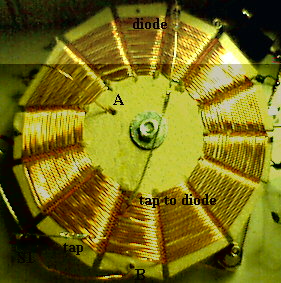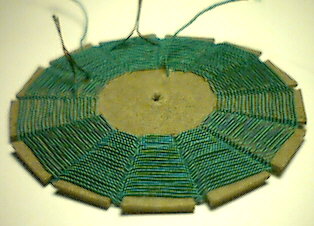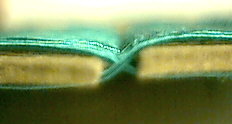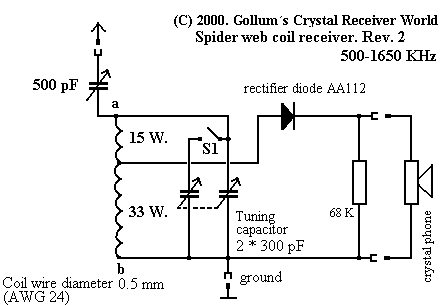Spider Web Coil Crystal Receiver
for short antennas.
High selectivity, high sensitivity.
!!! Station ODX 1521 miles with this receiver !!!
I have logged in one week with this receiver 55 broadcast stations in 22 European countries.
Solid wire coil and litz wire coil.
Realized receivers of my visitors. Click here.
Spinnen-Netz-Spulen-Detektorempfaenger
fuer kurze Antennen.
Hohe Selektion, hohe Empfindlichkeit.
!!! ODX mit diesem Empfaenger 2450 Km !!!
Ich habe mit diesem Empfaenger in einer Woche 55 Radio-Stationen aus 22 europaeischen Laendern empfangen.
Volldraht-Spule und Litzen-Draht-Spule.
Nachgebaute Empfaenger meiner Gaeste. Hier klicken.

| The drawing shows only the principle of winding the coil and not the actual number of turns. | Die obige Prinzip-Spule hat nur 5 Beispiel-Windungen! |

Solid wire coil
Greatest reception distance (ODX) with this coil: 810 miles (1304 Km).
See reception report 1 and 2 below.
Groesste Empfangsentfernung (ODX) mit dieser Spule 1304 Km. Siehe Empfangsbericht
1 und 2 weiter unter.

Solid wire 24 AWG.
Volldraht 0,5mm.

Litz wire coil
Greatest reception distance (ODX) with this coil: 1521 miles
(2450 Km). See reception report 3 below.
Groesste Empfangsentfernung (ODX) mit dieser Spule: 2450 Km. Siehe
Empfangsbericht 3 weiter unten.

Silk covered (served) litz wire 30/44. Important: Regular distance of
the wire! Adjust the loacation of the wire carefully.
Wichtig: Gleichmaessiger Abstand der Draehte! Justieren Sie die Lage
der Draehte sorgfaeltig.

Close up / Nahaufnahme

Schematic / Schaltbild
Coil: The coil is of spider web construction. Use stiff cardboard with a thickness of about 1.5 mm (1/16 inch). Cut 13 slots as shown (uneven number is important). Use magnet wire AWG # 24 to wind the coil on the slotted former zig-zagging the wire through the slots. Start counterclockwise at point a and weave the wire through the slots while progressively spiraling outward. A little care in winding produces a neat-looking coil (not quit sowith my above shown laboratory solid wire model). To prevent the cardboard coil former to become humid you can spray-paint it with a suitable lacquer. Use solid copper wire or better r.f. litz wire. More information about litz wire you will find here. Compare the effect of the solid wire or litz wire coil at my reception reports below. Total approx. 44 feet coil wire. Here you can order r.f. litz wire. Inner coil windings radius 0.7 inch, outer radius 1.6 inch. (A ready to use spider web coil cou can order here. You use only one of three taps of this coil type 8a. You can test also the best matching of your diode.)
Remark about the 13 slots of my spider net coils: I am asked again and again (too in American "Crystal Receiver" forums, this question was discussed in relation to my construction projects), why 13 instead of 11 or 9 slots. That is very simple. 13 slots yield a more stable situation of the turns. The parallel widing pieces are shorter. Therefore, they can not "touch" so easily to the neighbor turn.
Tuning capacitor: I use a two-section (2-gang) 320 pF or 330 pf air-spaced variable capacitor. You can order these tuning caps here (best type is # 18). When your capacitor is only 500 pF you will have to add two turns to the coil at points a and b respectively or yo use my coil type 8a.
Antenna matching capacitor: This capacitor (approx. 350 or 500 pF) (solid dielectric) matches your antenna to the circuit.
- Tight coupling = high volume, low selectivity, small frequency range
- Loose coupling = lower volume, high selectivity, large frequency range
- The higher the frequency, the lower the coupling.
- Adjust always the coupling as little as possible.
Switch 1:
- Closed: Frequency range is about 520 to 1400 KHz
- Open: Frequency range is about 600 to 1650 KHz.
(Translation German/English courtesy Peter Stepponat )
Spule: Als Spule wird eine sogenannte "Spinnen-Netz-Spule" verwendet. In einen 1,5 mm starken Pappkarton werden 13 Schlitze geschnitten. Der Draht wird wechselseitig durch die Schlitze gefuehrt. Bei sorgfaeltiger Verlegung des Drahtes kann ein gleichmaessiger Abstand zwischen den Windungen erreicht werden (nicht so bei meinem oben gezeigten Volldraht Labor-Aufbau). Sie koennen die Pappe auch mit Plastik-Spray versiegeln, damit keine Feuchtigkeit eindringen kann. Nutzen Sie Kupfervolldraht oder besser HF-Litze. Mehr Informationen ueber Litze finden Sie hier. Vergleichen Sie die Wirkung der Litzen- oder Volldraht-Spule bei meinen Empfangs-Berichten weiter unten. Insgesamt ca 14 Spulendraht. Hier koennen Sie HF-Litze erwerben. Spulenwicklungs-Aussen-Radius 4 cm, Innnen- Radius 1,8 cm. (Eine fertige Spule koennen Sie hier erwerben. Bei dieser Spule Typ 8a nutzen Sie nur eine der 3 Anzapfungen. Sie koennenen bei dieser Spule auch Versuche mit der besten Anpassung der Diode machen)
Bemerkung zu den 13 Schlitzen meiner Spinnennetz-Spulen: Ich werde immer wieder gefragt, (auch in amerikanischen "Crystal Receiver" Foren wurde diese Frage unter Bezugnahme auf meinen Bauvorschlaegen diskutiert) warum 13 statt 11 oder 9 Schlitze. Das ist ganz einfach. 13 Schlitze ergeben eine stabilere Lage der Windungen. Die jeweils parallelen Drahtstuecke sind kuerzer. Deshalb koennen sie sich nicht so leicht an die Nachbarwindung anlegen.
Drehkondensator: Als Drehko benutze ich einen 2*320 pF oder 2*330 pf - luftisolierten Drehko. Diese Drehkondensatoren koennen Sie hier erwerben (am besten Typ 18). Wenn Sie nur einen 500 pF-Drehko haben, muss die Spule bei A und B jeweils 2 Zusatzwindungen erhalten oder Sie verwenden meine Spule Typ 8a.
Antennen-Drehko: Mit diesem Drehko (ca 350 oder 500 pF) passen Sie die Antenne an den Schwingkreis an.
- Feste Kopplung = hohe Lautstaerke, geringe Selektion, geringer Frequenzbereich.
- Lose Kopplung = kleine Lautstaerke, hohe Selektion, grosser Frequenzbereich.
- Je hoeher die Frequenz, desto geringer die Kopplung.
- Stellen Sie immer die Kopplung so gering wie moeglich ein.
Schalter 1:
- Geschlossen: Frequenzbereich ca. 520-1400 KHz
- Offen: Frequenzbereich ca. 600 - 1650 KHz.